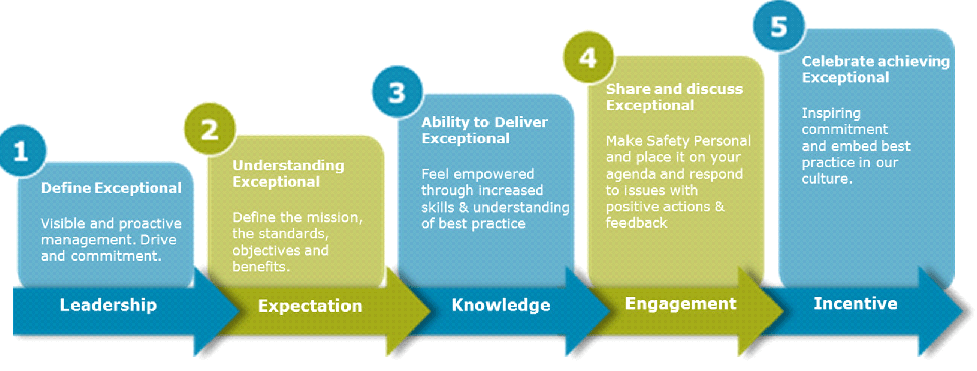Organisations today are increasingly challenged to demonstrate that they have effective health, safety and wellbeing processes in place – but how? Assurance is the goal – maturity is the requirement – data is the key. Mike Taylor and Martin Cook, Turner & Townsend, explain.
Within every health, safety and wellbeing (HSW) process there has to be an effective culture, driven by individual behaviours (at all levels), and underpinned by an effective management system / framework with clear expectations and goals to ensure effective HSW performance. Achieving this requires a level of HSW maturity within the organisation to accept its limitations, solve its problems and celebrate its success.
This is expressed diagrammatically below:

- Policy – goals and expectations – an effective road map and common understanding of where the organisation is headed;
- Process and systems – an effective set of processes to deliver excellence in HSW performance – right first time, every time;
- Behavioural safety – correct individual behaviours with everyone looking after themselves and others to keep healthy and safe;
- Cultural health, safety and wellbeing – the organisation operating as one, with a clear cultural belief and caring for wellbeing of employees and others.
To assure this in an organisation is difficult, as data is not always available, and when it is extensive verification and validation is required.
Data and Assurance
- Assurance is about having effective tools in place to determine the level of maturity within an organisation. The key to unlocking these assurance objectives is effective data capture, interpretation and presentation.
- Turner and Townsend are able to assist in assuring HSW processes through the capture and use of real-time data presented in an effective format. This enables an organisation to visualise its processes in a completely different light and often leads to fundamental paradigm shifts in performance.
The maturity of data used within assurance tools must be clearly understood and validated. Clearly chaotic and reactive data will not give the same levels of assurance as clearly defined, proactive, and better still, predictive data. Turner and Townsend can help by classifying the data collected, allowing organisations to use the tools above to clearly and effectively present the assurance of their HSW systems in unique and insightful ways.
How do we get the data
We get the required data by carrying out a series of surveys, questioning the intent, effectiveness and views of people at all levels of the organisation on HSW performance.

By focussing on our “Five Safety Enablers” we are able to determine the maturity of an organisation and recommend specific improvements. These enablers are:
- Leadership – visible and proactive;
- Expectation – setting the standards;
- Knowledge – educate and train;
- Engagement – consistent message of ‘care and concern’; and
- Incentive – acknowledge and reward.
The survey itself is structured to capture the opinion of staff across the five pillars that underpin each level of maturity. This structure allows for recognition of both exceptional and below standard performance.
What do you get
Once the data is evaluated, we are in a unique position to develop and recommend a suite of proactive, leading performance indicators. Organisations can then use these to determine the most effective strategy, actions and monitoring processes for their unique level of maturity, and have confidence that their efforts will be driving real and tangible improvement (which and be further measured).
Data validation
We validate the information received through a process of analysis that determines if data collected sits between parameters that we would expect when determining the performance measures. Where discrepancies are identified we seek to confirm, or otherwise, the accuracy. Through this process of data validation we will deliver confidence in the data collected.
The ultimate prize!
Not only will these indicators allow the organisation to determine when they are improving, and to what extent, but will also potentially allow the organisation to predict where the next organisational failing may come from – in other words their next accident. It must not be made available or copied or otherwise quoted or referred to in whole or in part in any way, including orally, to any other party without our express written permission and we accept no liability of whatsoever nature for any use by any other party.
© Turner & Townsend Project Management Limited. This content is for general information purposes only and does not purport to constitute professional advice. We do not make any representation or give any warranty, express or implied, and shall not be liable for any losses or damages whatsoever, arising from reliance on information contained in this document.
For further information on any of our services visit our website www.turnerandtownsend.com
The Safety Conversation Podcast: Listen now!
The Safety Conversation with SHP (previously the Safety and Health Podcast) aims to bring you the latest news, insights and legislation updates in the form of interviews, discussions and panel debates from leading figures within the profession.
Find us on Apple Podcasts, Spotify and Google Podcasts, subscribe and join the conversation today!




Good introduction – great to see someone looking at these issues, especially ‘well-being’, and developing an OHS model that is addressing life beyond behavioural safety.
Hi Robin. Thanks for the comment. Martin and I believe there is definitely life beyond behavioural safety leading to employee wellbeing. You may have also seen Martin’s recent blog ‘Behavioural Safety – Has it lost its way’ which generated some interesting discussion at the SHE Expo. We firmly believe behavioural safety has its place in effective health and safety management, but is not the panacea people seem to think. The good to great model and the fact it leads to proactive health and safety management is a process we absolutely believe in and will be developing further. Mike T.